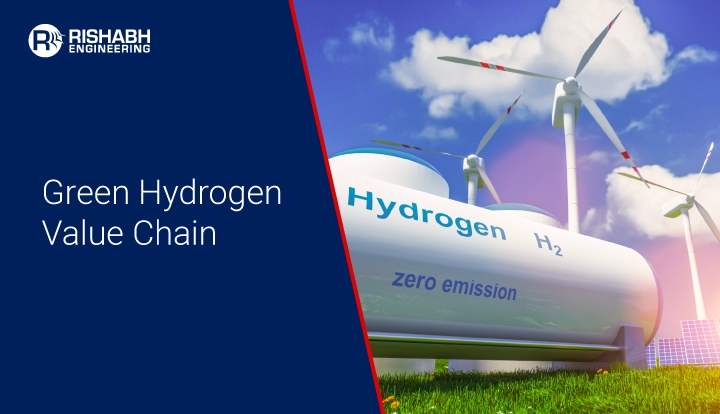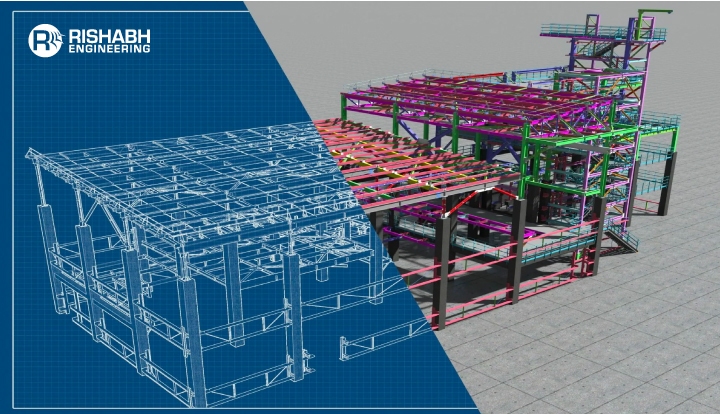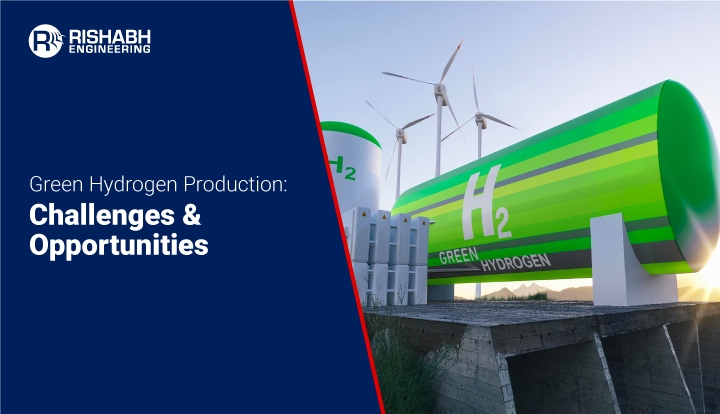
Navigating the Green Hydrogen Value Chain
Green hydrogen is a powerful contender for a more sustainable and environmentally friendly energy landscape. It has the potential to revolutionize various industries while significantly reducing carbon emissions. We must explore the intricate framework of developing green hydrogen to understand its full potential. The value chain encompasses the production, processing and purification, distribution, and storage from various sources. In this article, we will discuss the green hydrogen production value chain, examining each stage and understanding how Rishabh Engineering is poised to help companies across phases to reshape this global energy landscape.

Green Hydrogen Production Value Chain: Key Steps
Green hydrogen refers to hydrogen gas produced by its constituent elements, hydrogen (H2) and oxygen (O2). Read this blog to explore the current state of green hydrogen production. The green hydrogen value chain comprises several key stages, each crucial, as listed below;
- Production
- Processing
- Distribution and Storage
- Applications
Production
The hydrogen value chain begins with production, generating hydrogen from various feedstocks and natural resources. There are several hydrogen production methods, each with unique advantages and applications.
- Electrolysis (Water Splitting):
Advantages: Produces pure hydrogen without carbon emissions when powered by renewable energy.
Applications: For sectors aiming to reduce carbon emissions, like transportation and power generation. - Steam Methane Reforming (SMR):
Advantages: Cost-effective, mature technology widely used.
Applications: Industrial hydrogen production, such as for ammonia and methanol manufacturing. - Partial Oxidation (POX):
Advantages: Efficient, can use various hydrocarbons, produces a high-purity hydrogen stream.
Applications: Within industrial processes, chemical production, and power generation. - Autothermal Reforming (ATR):
Advantages: Combines SMR and POX characteristics, efficiency, and feedstock flexibility.
Applications: Used in hydrogen production for various industrial applications. - Photoelectrochemical (PEC) Water Splitting:
Advantages: Uses sunlight to split water, renewable and environmentally friendly.
Applications: Research and development for sustainable hydrogen production. - Thermochemical Water Splitting:
Advantages: Uses heat from concentrated solar power or other sources that can provide a continuous hydrogen supply.
Applications: Solar-driven hydrogen production for off-grid and remote locations. - High-Temperature Steam Electrolysis (HTSE):
Advantages: Operates at high temperatures, improving efficiency and reducing electricity consumption.
Applications: Efficient green hydrogen production, often integrated with nuclear or concentrated solar power. - Hydrogen Production from Natural Gas with Carbon Capture and Storage (CCS):
Advantages: Allows for hydrogen production from natural gas with carbon emissions captured and stored.
Applications: Transition technology to reduce emissions in hydrogen production until greener methods become widespread.
Listed above are the different methodologies of the H2 value chain that cater to organizations’ various needs and priorities, ranging from cost-effectiveness and industrial-scale production to sustainability and reduced carbon emissions. Ultimately, the choice of method depends on factors such as energy source availability, cost constraints, and environmental considerations.
Processing
The hydrogen produced must undergo further processing depending on the intended application. This may include purifying the hydrogen, removing impurities, separating carbon dioxide (CO2), and even cryogenic liquefaction. The processing stage ensures that the hydrogen has the desired purity and quality for its end use.
Distribution and Storage
Once the hydrogen is processed, it must be efficiently transported to its destination or stored until needed. The distribution and storage of hydrogen are critical steps in the value chain. Gaseous and liquid hydrogen transportation methods are employed, and storage solutions must ensure safety, reliability, and scalability.
Applications
Hydrogen is an essential element across various industrial processes. Its versatility and sustainability make it an ideal choice for numerous applications. This includes its use in chemical processes, refining, metalworking, and glass production, and as a potential clean fuel source for a more sustainable future.
How can Rishabh Engineering Help In the Green Hydrogen Production Value Chain?
We are an experienced green hydrogen engineering consultancy that helps customers develop sustainable engineering solutions, particularly within the sub-phases of green hydrogen production, processing, and distribution. Here are several ways in which we can contribute to the development and optimization of the green hydrogen value chain:
- Engineering and Design Expertise: Our team of highly skilled engineers and designers have a deep understanding of industrial processes. They can develop and optimize hydrogen production, processing, and distribution systems, ensuring efficiency and safety at every stage.
- Plant Design and Engineering: The company is well-equipped to design and engineer green hydrogen production facilities. This includes optimizing plant layout, selecting the right equipment, and ensuring operational efficiency.
- Purity and Quality Assurance: You agree that purity is paramount in the hydrogen value chain. We can provide process design and engineering services to optimize the purification and processing of green hydrogen. Our team puts into practice technologies and processes that guarantee high-quality hydrogen. The developed solutions encompass removing contaminants, separating carbon dioxide, and maintaining strict quality standards.
- Distribution and Storage Solutions: We have extensive experience designing efficient distribution and storage systems for hydrogen. Whether hydrogen is destined for industrial applications or as a fuel source, we can provide support to develop safe and reliable infrastructure for transportation and storage. Further, we can assist in designing safe and efficient transportation systems for gaseous and liquid green hydrogen, including pipelines, tanks, and distribution networks.
- Compliance with Environmental Regulations: Our team can most certainly assist you in ensuring that projects adhere to environmental regulations while utilizing carbon capture and storage technologies to facilitate the production of green hydrogen.
- Project Management: Successfully executing a hydrogen value chain project requires meticulous management. Our team ensures projects are completed on time and within budget.
Final Words
In conclusion, the green hydrogen value chain represents a transformative force pursuing a sustainable energy future. The promise of green hydrogen lies in its ability to harness renewable energy sources, reduce carbon emissions, and diversify our energy mix. This article explores the various stages of the green hydrogen value chain, from production to distribution and applications. With its experience in engineering, process optimization, and sustainable solutions, we’ve seen how Rishabh Engineering plays a vital role at every juncture.
Ready To Transform Your Hydrogen Value Chain?
Explore the limitless potential of green hydrogen with Rishabh Engineering to develop innovative solutions to reshape your energy landscape.
Related Blogs
Related Blogs
Best Structural Engineering Software for Accurate Analysis
Finding tools that simplify and improve the accuracy of the…
Detailed Engineering Considerations for Project Success
Engineering projects today require meticulous planning and execution across various…


